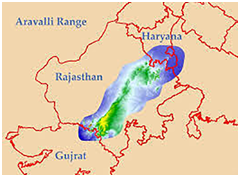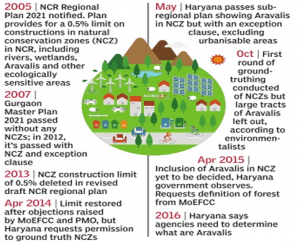THE CONTEXT: The Supreme Court judgement recently held protected land in Aravalli ranges as forests, guarding it against non-forest use. This article will analyse the implications of this judgement from the UPSC perspective.
BASICS ABOUT THE ARAVALLIS
LOCATION & FORMATION
- They stretch for a distance of about 720 km from Himmatnagar in Gujarat to Delhi, spanning Haryana, Rajasthan, Gujarat, and Delhi.

- The Aravallis date back to millions of years when a pre-Indian subcontinent collided with the mainland Eurasian Plate.
- The Aravallis of Northwestern India, one of the oldest fold mountains of the world, now form residual mountains with an elevation of 300m to 900m. Guru Shikhar Peak on Mount Abu is the highest peak in the Aravalli Range (1,722 m).
- It has been formed primarily of folded crust when two convergent plates move towards each other by the process called orogenic movement.
SIGNIFICANCE OF THE ARAVALLIS
ACTING AS A GREEN BARRIER
- The Aravallis act as a barrier between the fertile plains in the east and the sandy desert in the west.
- Historically, it is said that the Aravalli range checked the spread of the Thar desert towards the Indo-Gangetic plains, serving as a catchment of rivers and plains.
INFLUENCING CLIMATE & RAINFALL
- During monsoons, it forms a parallel wall to monsoon clouds moving eastwards, thus helping nurture the sub-Himalayan rivers and feeding the north Indian plains.
- In the winter months, it protects the fertile alluvial river valleys from the cold westerly winds from Central Asia.
HABITAT FOR DIVERSITY
- The Aravallis provides habitat to 300 native plant species, 120 bird species and many exclusive animals like the jackal and mongoose.
PROVIDING BREATHING SPACE
- This Aravalli range is considered the “lungs” for the polluted air of Delhi–National Capital Region (NCR).
- For Haryana, having the lowest forest cover at around 3.59% of the total forest cover in India, the Aravalli range is the only saving grace, providing the major portion of its forest cover (2017 Forest Survey Report).
PROTECTING THE ARAVALLIS: OFFICIAL DEVELOPMENTS & RULINGS
OFFICIAL DEFINITION OF THE ARAVALLIS `ARAVALLI NOTIFICATION’ (1992)
- In 1992, to protect the ecologically sensitive Aravallis, the ministry of environment and forests (MOEFCC) introduced what is colloquially called the Aravalli notification.
- It says that apart from reserved forests or places already classified as `forest’ in government records, areas categorised as gair mumkin pahar (uncultivable hill), gair mumkin rada (foothills, pastures), gair mumkin be hed (ravined foothills), Banjar beed (cultivable grassy foothills) and round (rocky areas between two hills) will be treated as Aravallis.
- The same status is also to be given now to any land classified under sections 4 and 5 of the Punjab Land Preservation Act. All such areas in NCR will be protected and identified as Aravallis; the MoEFCC has told the green court.
- The immediate implication is that it extends a protective cover to large swathes of land in NCR, especially in Gurgaon and Faridabad.
- Before this notification, the Haryana government claimed that the status of such land was not yet been decided, leaving them open to real estate projects. Before this, the Aravali notification was applicable only to Gurgaon and Alwar (Rajasthan).
EVOLUTION OF THE ARAVALLI ISSUE

IMPORTANT SUPREME COURT JUDGEMENTS
TN GODAVARMAN THIRUMULPAD ‘VS UNION OF INDIA (1996)
- Clarified definition of the forest: ‘Forest’ must be understood according to its ‘dictionary meaning’. The ‘SC asks states to identify accordingly.
- COMPLIANCE: Haryana hasn’t identified areas that fulfil the dictionary meaning of forest.
MC MEHTA VS UNION OF INDIA & OTHERS (2002)
- Ban on groundwater extraction and mining: The SC bans drawing groundwater in ‘an area within 5km radius of Delhi border on Haryana side
- and in the Aravalli hills. Also, mining in 448 sq km area of Aravallis in Faridabad, Gurgaon and Mewat.
- COMPLIANCE: Borewells are still active. Mining has reduced but not stopped altogether.
LAFARGE CASE (2011)
- The SC directs all states to complete the process of identifying forests.
- COMPLIANCE: Haryana has Not initiated the process yet.
ANSAL CASE (2012)
- Any change in revenue records to sell land invalid: Some areas recorded as ‘gair mumkin pahar’ were converted to ‘gair mumkin farmhouse’.
- The SC says these are not to be accepted
2018 KANT ENCLAVE CASE
- The SC said that area notified under PLPA in Haryana must be treated as ‘forest’ and ‘forest land’. The judgment regarding construction in the Aravalli hills of Haryana holds serious implications for the ongoing litigations and preservation of the entire Aravallis in Haryana.
- COMPLIANCE: The Haryana Assembly passed the controversial Punjab Land Preservation (Haryana Amendment) Act, 2019, which opens up nearly 30,000 hectares of protected land for development.
2022 JUDGEMENT BY SC
- The Supreme Court held that all land covered by the special orders issued under Section 4 of the Punjab Land Preservation Act (PLPA) in Haryana would be treated as forests and be entitled to protection under the 1980 Forest Conservation Act.
- Such land covered under Section 4 can see no commercial activity or non-forest use without the consent of the central government.
- It also stated that land covered by the special orders issued under Section 4 of PLPA has all the trappings of forest lands within the meaning of Section 2 of the Forest Act.
- The court directed the state government to clear any non-forest activity from such land in three months and report compliance.
- The bench considered a September 2018 judgment (Kant Enclave case) which held all land under PLPA could be treated as forest.
- The recent verdict clarified that the previous judgment failed to closely examine the scheme of Section 4 of PLPA and its legal effect in relation to Section 2 of the Forest Act.
SECTION 4 OF PLPA & SECTION 2 OF FOREST ACT: THE CAUSES OF CONCERN
Section 4 of the Punjab Land Preservation Act (PLPA):
- Special orders under Section 4 of PLPA are the restrictive provisions issued by the state government to prevent deforestation of a specified area that could lead to soil erosion.
- When the state government is satisfied that deforestation of a forest area forming part of a larger area is likely to lead to erosion of soil, the power under Section 4 can be exercised.
- Therefore, the specific land which a special order under Section 4 of PLPA has been issued will have all the trappings of a forest governed by the Forest Act.
- While the land notified under the special orders of Section 4 of PLPA shall be forest lands, not all land under PLPA will ipso facto become forest lands within the meaning of the Forest Act.
Section 2 of the Forest Act:
- Section 2 of the Forest Act imposes prohibitions on the de-reservation of forests or use of forest land for non-forest purposes without prior approval of the central government.
- Once land is covered under Section 2 of the Forest Act, whether the special orders under Section 4 continue to be in force or not, it shall continue to remain forest land.
Plans to override SC judgements: Analysing Government Steps
- Environmentalists fear the ruling may fast-track amendments to Forest (Conservation) Act (FCA), 1980. The amendments are likely to be tabled in the ongoing monsoon session of Parliament as the Forest (Conservation) Amendment Bill, 2022.
- As per FCA, activities like the felling of trees or activities like construction, mining and others are considered non-forest use. However, there is no clarity on whether afforestation or planting trees is a forest activity or a non-forest activity.
- The amendment bill aims to clarify the applicability of the Act in various types of land and to streamline the process of approvals. Changing forest conservation rules regarding clearance to projects and ease of business will have major ramifications.
- The forest Act draft proposed in 2021 wanted to remove the forest labels for a deemed wasteland or private forests.
- Under the new amendments, permissions will be granted by the state government instead of the Gram Sabhas. The government’s plan to create land banks by scrapping non-forest areas is just a step away from handing it over to commercial entities.
- While many ‘forests’ are proposed to be de-notified, Gram Sabhas and local communities are not being empowered to protect their rights.
THE WAY FORWARD
- Adhering to SC’s directives: Mining in the Aravalli region has been banned since 2002 under the Supreme Court orders unless expressly permitted by the Union Environment Ministry. However, mining continues illegally. The government should, thus, take immediate steps to follow SC’s directive regarding mining as well as encroachments, as mentioned in its other judgements.
- The Centre is contemplating an ambitious plan to create a 1,400km long and 5km wide green belt from Gujarat to the Delhi-Haryana border. Such projects need to be further upheld and supported by the states sharing the Aravalli ecology.
- There must be increased devolution of decision-making powers to gram sabhas.
THE CONCLUSION: The ethical dilemma of choosing between preserving the environment and the economic growth of the country is persistent for a developing nation like ours. For this, the policymakers must take into consideration the Constitutional morality, the commitments to Sustainable Development goals and the effective consensus of the local community for sustainable and inclusive policy formulations.
QUESTIONS TO PONDER
- “The ethical dilemma of choosing between preserving the environment and economic growth of the country is a persistent issue.” In the light of the statement, analyse the recent ruling of the Supreme Court, which considered protected land in Aravalli ranges as ‘forests.’

